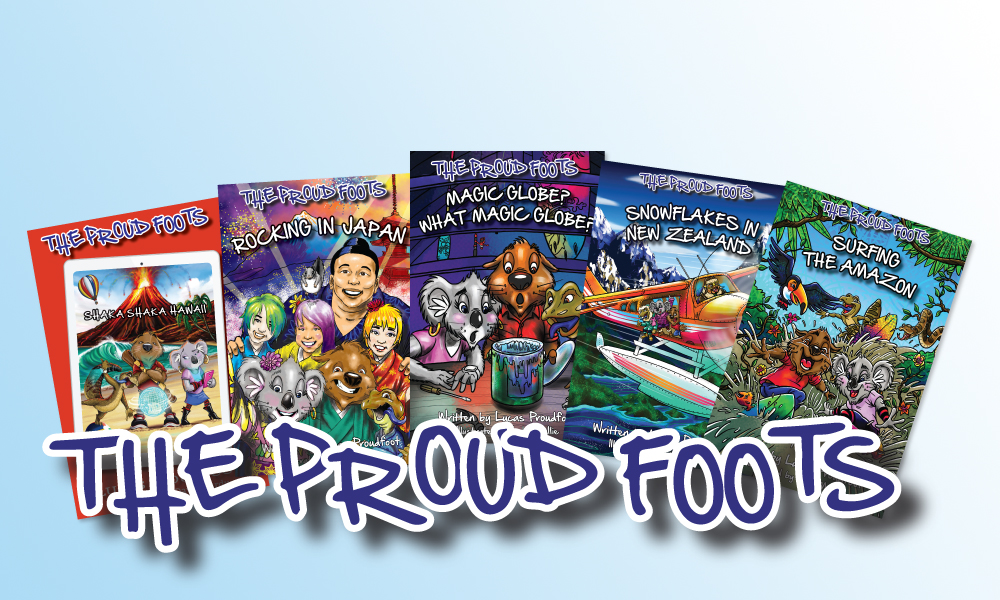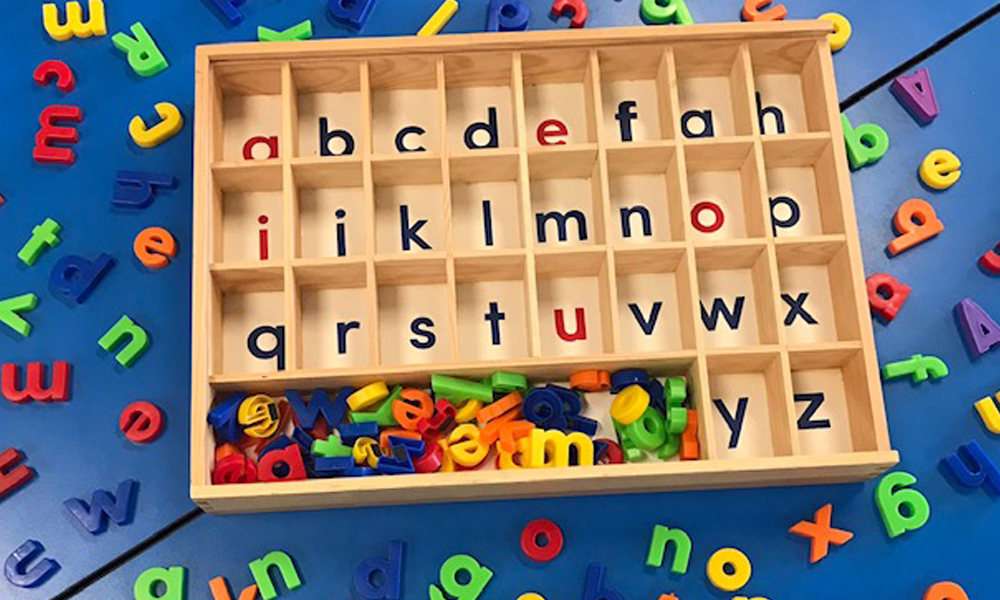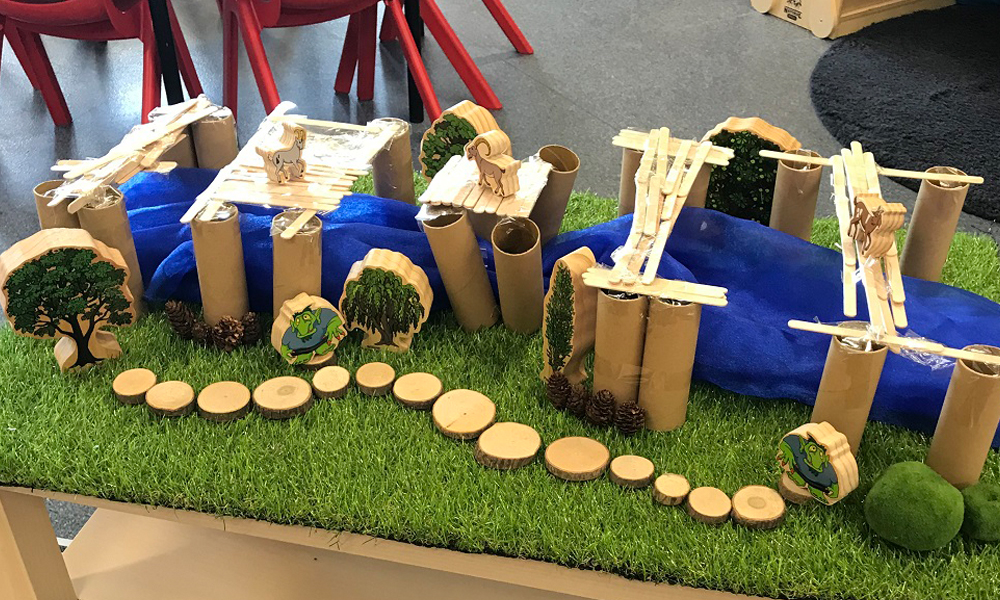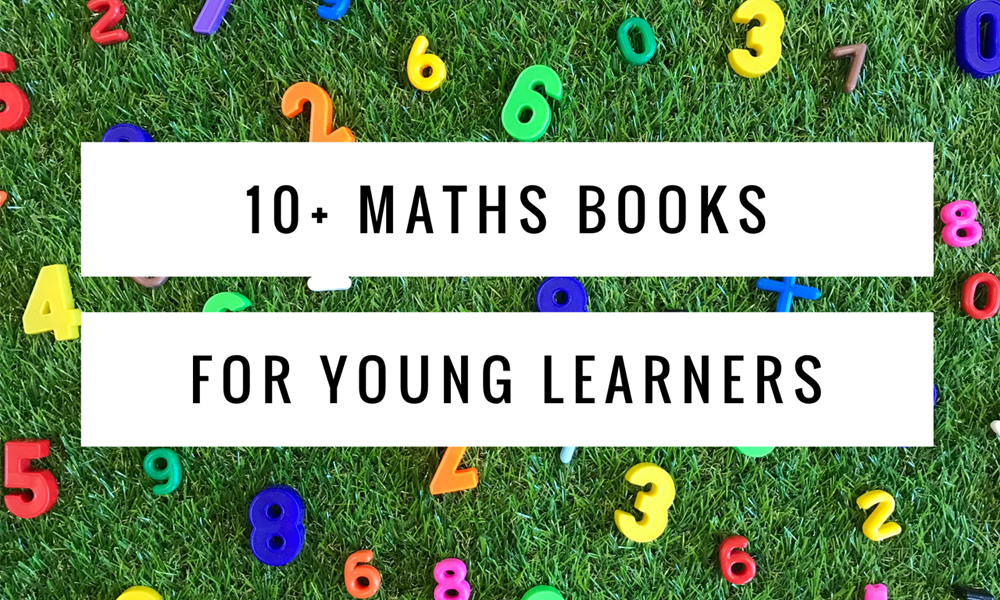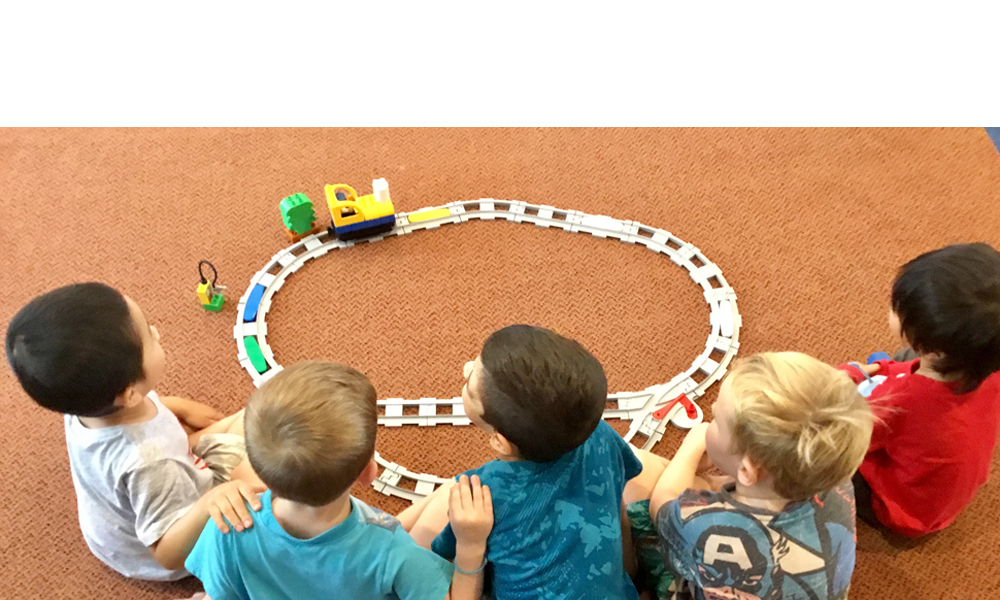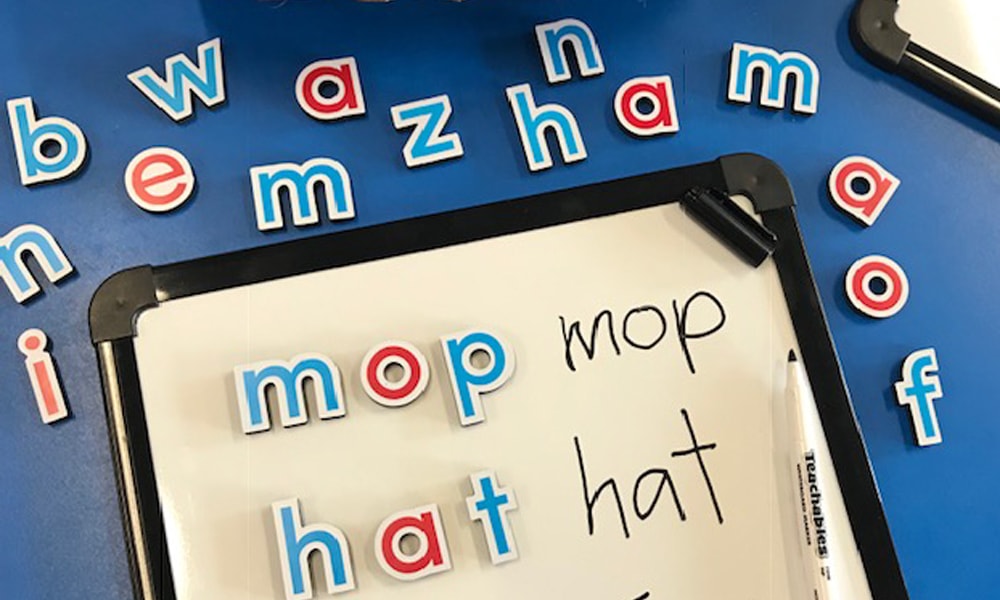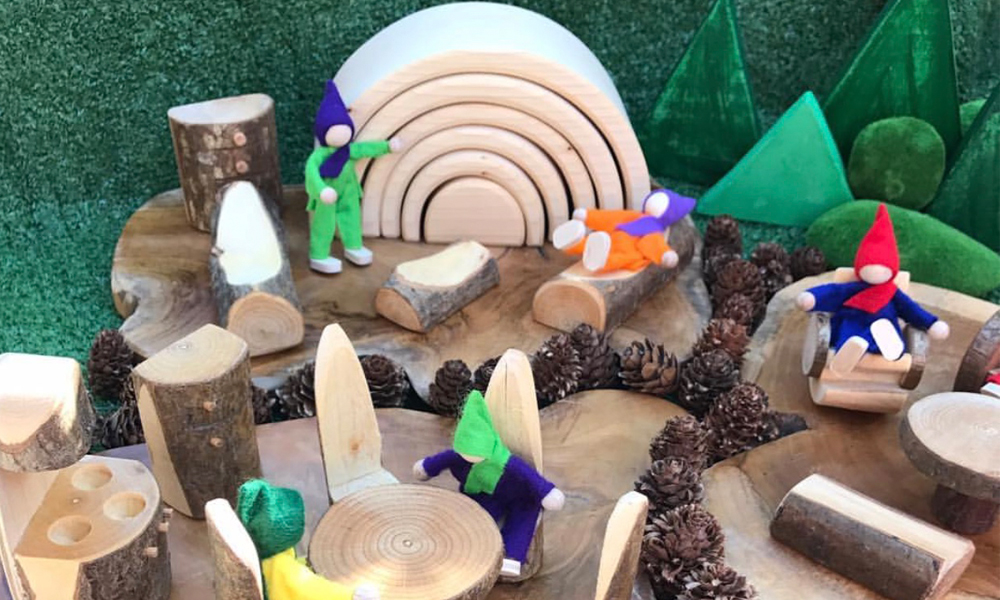In Part One of Early STEM Activities , I discussed what STEM is, why STEM is important, listed my favourite STEM materials and shared some of my favourite STEM activities. In Part Two of this Early STEM Activities blog, I am excited to share plenty more STEM ideas. Continue reading “Early STEM Activities: Part Two”
The Proud Foots Adventure Series: Q&A With Author Lucas Proudfoot
Lucas Proudfoot is one of Australia’s most versatile children’s performers, playing guitar, didgeridoo and stomp box to over 120,00 kids each year. He is a multi-platform storyteller, sharing stories through his music, books and live performances.
Following the release of his first book, Shaka Shaka Hawaii, from his five-part adventure book series, The Proud Foots, in 2017, Lucas emerged from an action-packed year of touring across the country to visit and perform as a headline guest at a number of writers’ festivals.
In 2018, Lucas continued his adventure with MTA to bring you the entire five-part book series released in 2019.
The Proud Foots is a five-part book series, which shares carefully crafted stories to include references to Australia’s diverse Aboriginal and Torres Strait Islander cultures and showcases other remarkable Indigenous cultures from around the world.
The stories are fun and engaging tools, intended to inspire young people to learn more about Indigenous cultures and the diversity and vibrancy they bring to our communities. These imaginative stories keep kids entertained and deliver powerful messages on a range of topics, allowing teachers and parents to continue the conversation in classrooms and homes across the country.
We sat down with author Lucas Proudfoot to celebrate the release of his new book series, The Proud Foots…
-
- What made you decide to write the Proud Foots books?
For the past ten years I’ve been performing in schools across Australia as a contemporary cultural performer and storyteller. Each year, the demand from teachers asking for more contemporary Indigenous content grew, so I decided that storybooks accompanied by music could be great starting point.
Right from the beginning, I wanted each story to be accessible to young readers right across the country, which is why I like to combine relatable themes, like family and respect, with positive representations of and interactions with Indigenous cultures, both in Australia and beyond.
Overall, it was important to me that the books have a contemporary cultural feel, which hopefully gives teachers the confidence to continue the conversation within the classroom.
-
- What was your inspiration for the Proud Foots characters?
Touring and performing across Australia has allowed me to experience first-hand the different sights and sounds of each region, including the wildlife.
A few years ago, I remember watching chubby little wombats in country Victoria scampering around in a field which was hilarious. They were play-fighting, having a ball and that’s what sparked the idea for Pat the Wombat.
Pat the Wombat was originally written as a song, but throughout the verses he needed some friends to go surf and eat with, so that’s when Koolaz Koala and Billy Blue-Tongue were introduced. I’ve seen many koalas sitting up high and mighty in school playground trees and I’ve always been intrigued by the laidback nature of blue-tongue lizards.
Next, Pat, Koolaz and Billy needed a place to live, so the setting of Foot Stomp Creek was directly inspired from where I grew up on the Tweed Coast of NSW – Bundjalung country.
I come from a strong saltwater community where everything revolves around the ocean, rivers, creeks, fertile red soil lands and weather. This beautiful environment provided a livelihood for many Aboriginal and Islander families living in the region, especially through fishing practices that were passed down from generation to generation.
Growing up, I surfed, fished and played sport with not only my cousins but also the wider community and knew this setting would be ideal for a storybook series like the Proud Foots.
-
- Where do the ideas for your stories come from?
My upbringing on the Tweed Coast definitely inspires the stories I write, but I’m also writing about my experiences of travelling the world as a cultural performer and former professional surfer.
I’ve been fortunate enough to travel to over 25 different countries and so I wanted a way to allow Pat, Koolaz and Billy to travel to the places I’ve been, which is where the idea of the Magic Globe came from. This was how the story world of the Proud Foots came to life, and the adventures that Pat, Koolaz and Billy go on have a basis in my own real life experiences in those places. The many cultural interactions I had around the world are reflected in each story and obviously there is a fun mix of fact and fiction to keep young readers entertained along the way.
-
- Who would enjoy these books?
I’ve been touring the Proud Foots live show for over two years now in schools, literature festivals and libraries. After over 500 performances, I’ve found that the books have a very broad appeal. From 3 to 12 year olds, both boys and girls can find something in each character to relate to. I wanted the characters to be well-rounded and authentic, for example Pat is always up for an adventure but he’s also the first to get a bit wobbly when it comes to danger! Billy is definitely the class clown (we’re either laughing with him or at him!) and Koolaz Koala’s witty, smart, quick-thinking attitude definitely strikes a chord with young girls and boys alike.
Being a father myself, it was also important to me that these books be enjoyable for adults when reading along with their children. I added some subtle humour and references that will hopefully keep adults and older readers entertained, and I’ve had some great feedback from parents who tell me that they have a quiet chuckle to themselves when they’re reading aloud, which is music to my ears!
Overall the fun, fast-paced nature of each book appeals to even the most reluctant reader as they are not long, intimidating reads but short stories that flow with an exciting adventurous feel.
-
- What can readers expect from the books?
Each story has multi-layered messaging, as I like to combine many things like action, adventure, culture, comedy, discovery and danger, whilst also slipping in some fun facts. Highlighting the various cultural traditions and iconic landmarks of each country is important as well, e.g. volcanoes in Hawaii, Mount Fuji in Japan, the Amazon rainforest in Brazil and so on. Including these well-known elements from each location helps to make the entry into a new culture more accessible and opens the door to broader ideas and understanding.
The importance of respecting different cultures, nurturing friendships and working as a team will always be an underlying theme in the Proud Foots book series.
-
- How does your music influence your writing?
The music I create and perform directly fuels my creative process as a writer. As mentioned, Pat the Wombat was originally written as a song but eventually turned into a whole story world around that one character. Writing lyrics for me is the same as writing a draft copy of a story; only it’s in short form. As a writer I’m fortunate enough to try these creative ideas with my reader age group on a regular basis when performing in schools. I usually know within the first few minutes if it’s working and if it is, I will keep refining the idea until it turns into a potential song or story. Ultimately both music and writing go hand in hand for me.
-
- What is the writing process like?
I like to write with clarity, which equals good coffee! So early mornings work best for me, usually between 4-7am. Sometimes my writing sessions are simply draft copy read-throughs with some minor edits here and there. Other days I’ll write 1500+ words.
I also like to take advantage of when I’m touring interstate, as I have no surprise disruptions from my beautiful 3-year-old daughter who thinks the keyboard is a grand piano!
I’ve tried writing in the evenings but I feel my creative process has somewhat waned due to shows and travel earlier that day.
-
- What advice would you give to any budding authors?
My advice for aspiring authors is to write about what you’re passionate about. It’s a great starting point and allows you to get at least something down on paper, even if it’s only a few sentences. Often students in my workshops will say they don’t have any stories. I then ask them what they did on the weekend or what their favourite thing to do is. From there they suddenly start telling me all these different stories and we’re off to the races!
Reading as many books as possible is also extremely valuable. It exposes you to different styles of writing, pacing, structure, language and so on. Personally, I find the more I read, the more confidence I have in my writing.
-
- What does the future hold for the Proud Foots?
Throughout 2019 I’ll be touring the Proud Foots books nationwide with a range of school and festival performances, which is an awesome way to connect with my audience.
You may also see the characters appearing in their own live stage show in the near future as kids are already asking me, ‘Where are the Proud Foots? Why aren’t they on stage with you?’ as well as, ‘Is your last name really Proudfoot?’ (I get that one a lot!).
There are plenty more stories in the vault, so I’m really excited to see what the future holds.
The Proud Foot Adventure Series is exclusively available from MTA
All Time Favourite Literacy Resources
Developing literacy skills in young students is extremely important in the early years and a large proportion of the school day is spent teaching these skills. To help me develop my students’ literacy skills, I use a wide variety of teaching tools and resources within my literacy program. Over the past few years, my collection of literacy resources has grown, yet I always seem to return back to my favourites; the resources that can be used in a myriad of ways. In this blog, I have compiled a list of my ALL TIME favourite literacy resources that I use regularly in my classroom and explain the different ways they can be used.
Chunky Alphabet Beads

There is something about threading activities that really captivates children’s attention. I have used these Chunky Alphabet Beads in both kindergarten and school settings and both age groups have adored them. On top of the obvious hand-eye coordination and fine motor skills that threading resources promote, there is also a range of literacy skills that these Chunky Alphabet Beads encourage. I have used these beads with my students to develop their letter recognition skills, name and word building skills, as well as awareness of uppercase and lowercase letters and alphabet sequence. Some of the activities I have implemented using these Chunky Alphabet Beads include:
-
- Spelling names (focus on using uppercase letter followed by lowercase)
- Spelling sight words
- Spelling CVC words
- Matching uppercase and lowercase beads together
- Sequencing the alphabet
- Letter finds (e.g. finding all of the e’s, or finding the letter that makes a /s/ sound)

Featured Products:
Chunky Alphabet Beads
Flower Sorting Tray
Wooden Alphabet Sorting Tray

I LOVE resources that can be used in a variety of ways, which is why this Wooden Alphabet Sorting Tray is included in my list of All Time Favourite Literacy Resources. I’ve lost count of the number of times I have used this tray in my early years classroom and it is one of my ‘go-to’ resources when planning hands-on activities for literacy rotations. Some of the activities I have implemented using this Wooden Alphabet Sorting Tray include:
-
- Sorting and matching magnetic letters into compartments (using tongs for added fine motor opportunities)
- Matching an uppercase letter manipulative with the matching lowercase compartment
- Practising letter formation by writing letters of the alphabet on a piece of paper and then placing them in the matching compartment
- Writing words that start with each letter on a piece of paper and then placing them in the correct compartment
- Beginning sound match-up (having a range of small toys and sorting them into the correct compartment according to their beginning phoneme)

Featured Products:
Wooden Alphabet Sorting Tray
Easy Grip Tweezers
Magnetic Lowercase Letters
Alphabet Bean Bags

In early years classrooms, there are many times in the day when students are transitioning from one activity to another. I like using these transition times as a teachable moment to consolidate learning and to give the children an opportunity to showcase their understanding. One of my favourite ways to transition students (e.g. from the carpet to the tables) is by throwing an alphabet beanbag to each student. Each child will catch their beanbag and tell the class what letter they are holding. This activity can also be adapted by having the student explain what sound that letter makes, or say a word that starts with that letter. Besides transitioning, other activities I have implemented using these alphabet beanbags include:
-
- Throwing beanbags into a hula hoop and saying the name of letter/correlating sound
- Laying letter cards out on the carpet and throwing the beanbags on top of matching letters
- Uppercase/Lowercase game where the beanbag is thrown and then depending on what side it lands on, students will say “Uppercase!” or “Lowercase!”

Featured Products:
Alphabet Bean Bags
Alphabet Wall Frieze
Phonix CVC Group Work Set

These Phonix Cubes are a staple in my classroom and can be used throughout the year as our learning focus changes depending on our English unit. These Phonix Cubes come with a set of pictorial work cards for word building, which my students love using in English rotations. Students use the pictorial work cards along with the Phonix Cubes to build CVC words. My students are always excited to show me what CVC word they have built and I find this particular resource great for developing students’ confidence with word building.

Along with making CVC words, some of the other ways we have used these Phonix cubes in the classroom include:
-
- Building sight words
- Building word families
- Building names (they have uppercase on one side, lowercase on the other)
- Sequencing the letters of the alphabet (my students love this one because they end up with a really long creation, which they think is fun!)

Featured Product:
Lowercase Alphabet Dough Stampers

Playdough is ALWAYS a hit in my classroom and is perfect for developing those important fine motor skills as well as allowing children to engage in sensory play. To add an extra element to playdough play, I love adding these Alphabet Stampers to our playdough table to encourage letter exploration and word building. We frequently use our Alphabet Stampers to practise our sight words, which is a great way for students to familiarise recognising, reading and spelling these important words. Other ways we have used these Alphabet Stampers in our classroom include:
-
- Stamping names into playdough
- Stamping CVC words into playdough
- Tracing letters with a finger after stamping

Featured Product:
Lowercase Alphabet Dough Stampers
Write and Wipe Sleeves

These Write and Wipe Sleeves have saved me SO much time and money over the past year, which is why I’ve included them on my All Time Favourite Literacy Resources list! What teacher doesn’t love saving time and money?! There is no need to laminate sheets with these Write and Wipe Sleeves, I simply place whatever sheet I need for the lesson inside the sleeve and then voilà! Students can write with whiteboard markers on these sleeves and then easily wipe away. Some of the activities we have used these Write and Wipe Sleeves for include:
-
- Roll and Write sight words
- Tracing and writing sight words
- Tracing letters or using resources (rocks etc) to trace over letters
- Making playdough letters

Storywands

Developing oral language skills and comprehension skills are vital components of our early years curriculum. One of my favourite resources to support development of both of these skills are Storywands. Storywands are a fun way to encourage discussion and understanding of stories. We have used them in whole-group shared reading sessions, as well as small-group guided reading. Each star has a different question on it, which encourages students to focus on different story elements. These Storywands are used extensively as part of our reading program and in a variety of ways, including:
-
- In whole-group shared reading
- In small-group guided reading (where each student answers a question)
- Using one star per lesson as a focus (for example, students will draw a picture to answer the question, ‘How did the story end?’)
- To focus on developing the reading skill of prediction
- To focus on developing oral retelling skills

Wooden Alphabet Discs

I have a weakness for any type of wooden resource – especially ones that can be used in so many ways! These Wooden Alphabet Discs have 26 uppercase and 26 lowercase discs and are perfect for simple letter recognition and letter matching games. I have used these beauties in both kindergarten and school settings in a variety of ways, including:
-
- Letter match-up sheets (matching letters, matching uppercase to lowercase)
- Looking for alphabet discs in rainbow rice

- Separating numbers and letters (with the addition of Wooden Number Discs)
- Letter Partner game (hand out uppercase and lowercase discs to students and then they have to find their partner with the matching letter)

Featured Products:
Wooden Alphabet Discs
Active World Tray
Coloured Plastic Bowls – Set of 6
Easy Grip Tweezers
1-20 Wooden Number Matching Discs – 40pc
Lowercase Letter Beads

You already know that my students LOVE threading activities, so it probably won’t surprise you that I have included these Lowercase Letter Beads in my list of All Time Favourite Literacy Resources. I love that these beads are lowercase and they can be used with lots of different tools such as string, laces or even pipe cleaners. We mainly use these beads to practise spelling our sight words. Our favourite way to do this is by threading them onto a string as well as using tongs to pick them up and arrange them into a word. Other ways we have used these Lowercase Letter Beads in the classroom include:
-
- Spelling names
- Sequencing letters in the alphabet
- Creating a string of words in word families (e.g. mat, cat, sat)

Featured Products:
Lowercase Letter Beads – 288 pieces
Fine Motor Tweezer Tongs
Alphabet Soup Sorter Cans

Last, but definitely not least, on my list of All Time Favourite Literacy Resources are these Alphabet Soup Sorter Cans. My students always get super excited whenever I bring these out because of their fun nature and opportunities for hands-on learning. This resource encourages students to sort the object and letter cards into the correlating cans and supports alphabet awareness, letter and sound recognition. Some of the ways I have used this resource in my classroom include:
-
- Whole group activities when introducing a letter/sound
- Consolidating a group of sounds (e.g. SATPIN)
- Small group sorting with some or all cans

Featured Product:
Have you used any of these resources within your literacy program? What is your all time favourite literacy resource? We’d love to hear from you.
ABOUT HEIDI:
Heidi Overbye from Learning Through Play is a Brisbane based, Early Years Teacher who currently teaches Prep, the first year of formal schooling in Queensland. Heidi is an advocate for play-based, hands-on learning experiences and creating stimulating and creative learning spaces. Heidi shares what happens in her classroom daily on her Instagram page, Learning Through Play. See @learning.through.play for a huge range of activities, play spaces and lesson ideas.
Early STEM Activities: Part One
STEM! It’s a word we have all been hearing a lot about lately! At the beginning of this year, I started teaching at a new school and quickly learnt that STEM was a focus for teaching and learning. To be honest, I felt quite nervous because I did not know much about STEM when I started. I had so many questions… What exactly is STEM? What does it look like with 5 year olds? Continue reading “Early STEM Activities: Part One”
Fostering Independence
We often think of independence in young children as an end goal, something to work towards with the finish line being adulthood. What we often don’t consider, however, is that there is no magical point in time where we think, “AHA…we passed the line, independence has been achieved!” Continue reading “Fostering Independence”
10+ Maths Books For Young Learners
In my Prep classroom, one of our favourite times of the day is when we come together to enjoy a story. Some people assume that reading stories is strictly part of English lessons – this couldn’t be further from the truth! There are so many fabulous maths books out there that captivate children’s interests Continue reading “10+ Maths Books For Young Learners”
Building Resilient Kids One Classroom At A Time
In its recent review of early intervention resources for children from birth to 12 years, Australia’s National Mental Health Commission found that 83 per cent of experts agreed that ‘increasing resilience among children aged 0–12 could potentially prevent mental health issues during childhood and/or later in life’. As teachers, we know that our students’ well-being is not just related to their physical health.
Continue reading “Building Resilient Kids One Classroom At A Time”
LEGO Education® Coding Express: An Educator’s Experience
Skye Spencer, an Early Years Teacher who works at Redman House 2 Early Learning Services in Sydney talks to us about her experience of using LEGO® Education Coding Express in the classroom.
Continue reading “LEGO Education® Coding Express: An Educator’s Experience”
Teaching With Teachables
You know those resources that you use every day in your classroom that make your life easier? That’s how I feel about Teachables products. I discovered these resources when I started teaching Prep last year and they are, without a doubt, the teaching tools that I use most at school.
Writing is a huge focus in my classroom, and I spend a lot of time each day engaging my students in writing through different ways and with different resources. In this blog post, I will go through how I use products from the Teachables range in my classroom as part of my writing curriculum.
Whole Group Teaching and Learning
In Prep, there are a lot of times during the day when we come together and engage in whole-group teaching and learning. Whether it be teaching proper letter formation or modelling writing sentences, I am constantly using my Teachables Magnetic Lined Write and Wipe Sheet. At my school, we teach students how to write on lines from the first term of school, so having this Lined Whiteboard near our group-time area is really handy as I am constantly using it to model writing.
Letter Formation

We use our Lined Write and Wipe Sheet a lot for learning about correct letter formation. When introducing a letter to my students, I will model how to correctly form that letter before students go to the tables and engage in activities to reinforce this learning. As a transition to the tables, students will come and have a go at writing this letter – my students just LOVE writing on the “teacher whiteboard”!
Sentence Work

In my classroom, we also use our Lined Whiteboard a lot for sentence work. In this routine, the focus is on developing students’ confidence with writing sentences, editing sentences through proofreading, using correct punctuation, using finger spaces between each word and forming letters properly. Usually, I will have a sentence typed up and we will read the sentence together before I cut and jumble it up (for a ‘transformation’). As a class, we put the sentence back together and then write the sentence underneath. Doing this together as a class means that I can model the expectations before students complete this task independently at the tables.

This particular sentence (pictured) was also linked to our English rhyme unit when we were exploring rhyming books and rhyming sentences.
Learning with Magnetic Letters
Magnetic letters are a fun and hands-on way for children to meaningfully engage with literacy. Magnetic letters are the perfect tool for developing letter recognition and letter formation as well as word building and sentence building. Over the course of my teaching career, I have used various types of magnetic letters in my classroom but the thing I love about the Teachables Magnetic Letters is that the letters are in print-sized font, there is a minimum of eight of each letter, which means students are always able to find the letters they need, and the vowels and consonants are colour-coded.
Word Building

One of the ways we use our Magnetic Letters is for word building. At this time of year, most of the word building work we are doing is around CVC (consonant-vowel-consonant) words. I will say to my students, “Let’s make a blue-red-blue word” so they can visually see that these words are made up of three letters – two consonants and one vowel.

Sometimes, we do word building as a whole class where we will choose a word, stretch it out so we can hear all of the sounds and then record the sounds through selecting magnetic letters. Other times, I will implement word building as a small group activity where students will build words with the magnetic letters and then write them on their magnetic whiteboards also.
Practising our Names

In the first term of Prep, learning to recognise, write and spell our names properly is a big focus. There are various ways I get my students to practise writing and making their names – sometimes we do artworks, sometimes we trace and other times we use hands-on materials to build and spell our names. A small group activity I like to set up during literacy rotations involves students making their names using the magnetic letters and then writing their name underneath. It’s a great way to practise!
Developing Letter and Number Formation
In Prep, we focus a lot on learning proper letter and number formation so that students can build confidence in their writing. There are several ways I encourage letter and number formation in my classroom and I love using different resources to build these skills such as sensory writing in rainbow rice or sand, on our Interactive Smartboard and using our Teachables Alphabet Whiteboard and Teachables Number Whiteboard.
Alphabet Whiteboard

The Teachables Alphabet Whiteboard comes in Foundation font, which is perfect for my Prep students as it is almost identical to the Queensland Beginner’s Font that we use. The whiteboards are double-sided with uppercase letters on one side and lowercase letters on the other. Usually, we will trace the lowercase side first together as a class and then turn over to the uppercase as part of our writing warm up.

The best part about these whiteboards is that they feature directional, numbered arrows to showcase the correct way to form each letter. I have seen a huge improvement in my students’ handwriting as they transfer their knowledge and practice from using the whiteboards into their independent writing.
Number Whiteboard

Similar to the Teachables Alphabet Whiteboard, the Teachables Number Whiteboard enables students to gain confidence with forming numerals correctly. There are four lines on the whiteboard, and as each line progresses, students must showcase increasing independence with forming numerals. I love this ‘gradual release’ system as it gives students confidence and guidance. The easy write on, wipe off surface of these whiteboards also makes it easy for students to correct mistakes and edit their work.
Encouraging Writing

Out of all of the Teachables products, these Lined Whiteboards are the resource I use most with my students, as it is extremely versatile. The lines on these whiteboards are spaced at 5.7cm, which makes them the perfect size for students of all ages and abilities to practise their writing, no matter how big or small their letters and words are.

This is especially useful for Prep students who are just beginning to learn how to write on lines and are still experimenting with the sizing of letters. Some of the ways we use our Lined Whiteboards include; practising letter formation, playing sight word games, writing out our favourite page from the book we read during guided reading and independent sentence writing.
Picture Story Whiteboards

My students love using these Picture Story Whiteboards because there is room to illustrate their piece of writing, and what child doesn’t love drawing? These whiteboards are ideal for allowing students to convey their ideas through text and illustrations. We use these Picture Story Whiteboards to write and draw sentences, write and draw about what we did on the weekend, as well as write more in-depth stories. When writing on these whiteboards, (as well as with all of the other Teachables resources) we use the Teachables Thin Lined Markers as they are the perfect width and students can write on the lines successfully.
Featured Products:
Teachables Magnetic Whiteboard – 30cm x 40cm
Teachables Lined Whiteboards – Pack of 30
Teachables Magnetic Lined Write & Wipe Sheet
Thinline Whiteboard Markers Black – Pack of 12
Teachables Picture Story Whiteboard – Pack of 30
Teachables Alphabet Whiteboard Foundation Font – Pack 30
Teachables Whiteboard Number Tracing – Pack of 30
I’ve shown you some of my favourite Teachables products. Which one of them would you like to use in your classroom? We would love to hear from you!
ABOUT HEIDI:
Heidi Overbye from Learning Through Play is a Brisbane based, Early Years Teacher who currently teaches Prep, the first year of formal schooling in Queensland. Heidi is an advocate for play-based, hands-on learning experiences and creating stimulating and creative learning spaces. Heidi shares what happens in her classroom daily on her Instagram page, Learning Through Play. See @learning.through.play for a huge range of activities, play spaces and lesson ideas.
How To Incorporate Natural Resources Into The Classroom – Part Two
There are so many ways nature can be brought into the classroom as part of children’s learning, and I shared lots of ideas in Part One of How to incorporate Natural Resources Into The Classroom Many of you really enjoyed the simple and effective ways I have managed to bring bits of nature into my classroom, which inspired me to share more of these ideas. Read on to find out how I incorporate more natural resources in the classroom.
Nature patterns

Can you create a pattern? One of my favourite times to incorporate natural items is during maths. Natural items extend themselves beautifully to teaching mathematical concepts, especially through hands-on learning. Whenever I am teaching my students about repeating patterns, I love presenting them with natural items for them to explore patterning with. In this activity, students were free to use natural materials to create and label their own patterns.
Featured Product:
Flower Sorting Tray
Can you make a leaf letter?

Leaves are just one of the most amazing natural resources to use in teaching and learning because they’re free, readily available and there are a plethora of ways they can be used! A few years ago, I had this learning space set up in my kindergarten classroom as an opportunity for literacy development. We read the book ‘We’re going on a leaf hunt’ and went on our own leaf hunt in the playground to collect the leaves we needed for this learning space. When children engaged with this stimulus, they created letters using the leaves and developed letter recognition skills and their understanding of letter formation.
Featured Products:
Nesting Wooden Trays – Set of 3
Three Way Mirror
Using flowers

Is it just me or does anyone else get really excited when they’re given flowers? And not just because flowers are amazing and incredibly thoughtful, but also because they can be used for activities once you’ve finished enjoying them! One of my favourite ways to use flowers in the classroom is for ‘potion-making’. Simply provide an ‘invitation to create’ for your students with flowers, water, leaves, glitter, bowls, wooden spoons and jars and watch them create and explore. Other activities you can do with flowers include nature-cutting, colour matching, threading and flower pressing.
Featured Product:
Flower Sorting Tray
Counting with twigs

As I mentioned before, I love using natural resources during maths lessons, particularly when we are engaging in hands-on rotations. Counting using one to one correspondence, recognising numerals, and matching collections to numerals are all crucial mathematical skills that are taught in the early years. Students developed all of these skills as they engaged with this activity where they had to select and recognise a number and then make a matching collection to represent that number using twigs. The addition of the tongs enabled students to develop they’re fine motor skills also.
Featured Products:
Tweezers
Natural Wooden Bowls
Hessian Sheets Natural
Matching Wooden Number Discs
Transient art with nature

Have you heard of the term ‘transient art’? Basically, it’s just a fancy term for moveable art – art that is not ‘fixed’. Transient art is continuously evolving and the focus is on the process, not the final product. When children engage in transient art experiences, they are able to manipulate, explore and experiment with materials and let their creativity and imaginations run wild.

Natural resources are perfect for transient artworks because of their open-ended nature. Items that I like using in transient art include leaves, pebbles, gemstones, small pinecones, circle branch cuts, rocks, small twigs, gum nuts and flowers. In this particular transient art experience, my students created artworks inside a frame using nothing but sticks, rocks and leaves. I was amazed at their creativity!
Natural Tree Blocks

These Natural Tree Blocks are my absolute favourite construction resource that encourages children to design, create and build. The blocks are absolutely stunning and are perfect if you’re looking for a straightforward way to integrate more natural items into your classroom.

We use these blocks a lot for both construction activities and in small world set-ups. We have even used them for building on our light-box panel! My students and I particularly enjoy using these blocks in small world play set-ups because their natural look makes the play space more realistic, especially once you add a couple of mossy stones, branch cuts and rocks!

Featured Products:
Wooden Tree Blocks
Bendable Wooden Family
Natural Wooden Living Room
Natural Wood Kitchen
Natural Wood Bedroom
Explore and Discover Light Panel
Wooden Fairytale Figures
Mossy stones – Set of 8
Active World Tray
Leaf crowns

Have you ever used contact paper to create crowns before? If you haven’t, I highly recommend it! It was an activity I learnt at university and I have used it many times in my teaching career because it’s such an easy (and mess-free!) way to make crowns. We made these ‘leaf crowns’ when I taught kindergarten several years ago. Simply stick your leaves and any other collage items you want to the contact paper, fold together, place around your head and voila! Your crown is ready to go!
Creating small worlds

One of the most common ways I incorporate natural items into my classroom is through small world set-ups. Whether it be presenting resources as an ‘invitation to create’ or setting up a small world play tray, I always include natural resources to make it ‘life-like’.

Can you imagine a jungle without trees, leaves and rocks? …Exactly! So by adding these natural pieces, the play space ‘comes to life’ and children are able to use these items in their play. My favourite natural resources to use in small worlds are; rocks, twigs, leaves, branch cut circles for stepping stones, sticks and pine cones. It is always interesting to see how children use these items creatively during their play.

Featured Products:
Flower Sorting Tray
Wooden Australian Trees
Bendable Wooden Family
Natural Wooden Living Room
Natural Wood Kitchen
Natural Wood Bedroom
Natural Wood Tunnel
Natural Wood Slices – Set of 3
Counting with Bud Cones

How sweet are these mini Bud Cones? I fell in love with them the first time I saw them and have been using them in my classroom ever since. A few years ago, I set up this really simple numeracy activity using these bud cones to encourage children to develop their one to one correspondence, counting skills and numeral recognition. In this activity, children were encouraged to make a matching collection using Bud Cones to represent each number. The addition of tweezers enabled children to develop their fine motor skills also.
MTA has lots of different types of sorting trays that could also be used…
Featured Products:
Nesting Wooden Trays – Set of 3
Tweezers
Active World Tray
What is your favourite natural resource to use in the classroom? We’d love to hear from you!
ABOUT HEIDI:
Heidi Overbye from Learning Through Play is a Brisbane based, Early Years Teacher who currently teaches Prep, the first year of formal schooling in Queensland. Heidi is an advocate for play-based, hands-on learning experiences and creating stimulating and creative learning spaces. Heidi shares what happens in her classroom daily on her Instagram page, Learning Through Play. See @learning.through.play for a huge range of activities, play spaces and lesson ideas.


